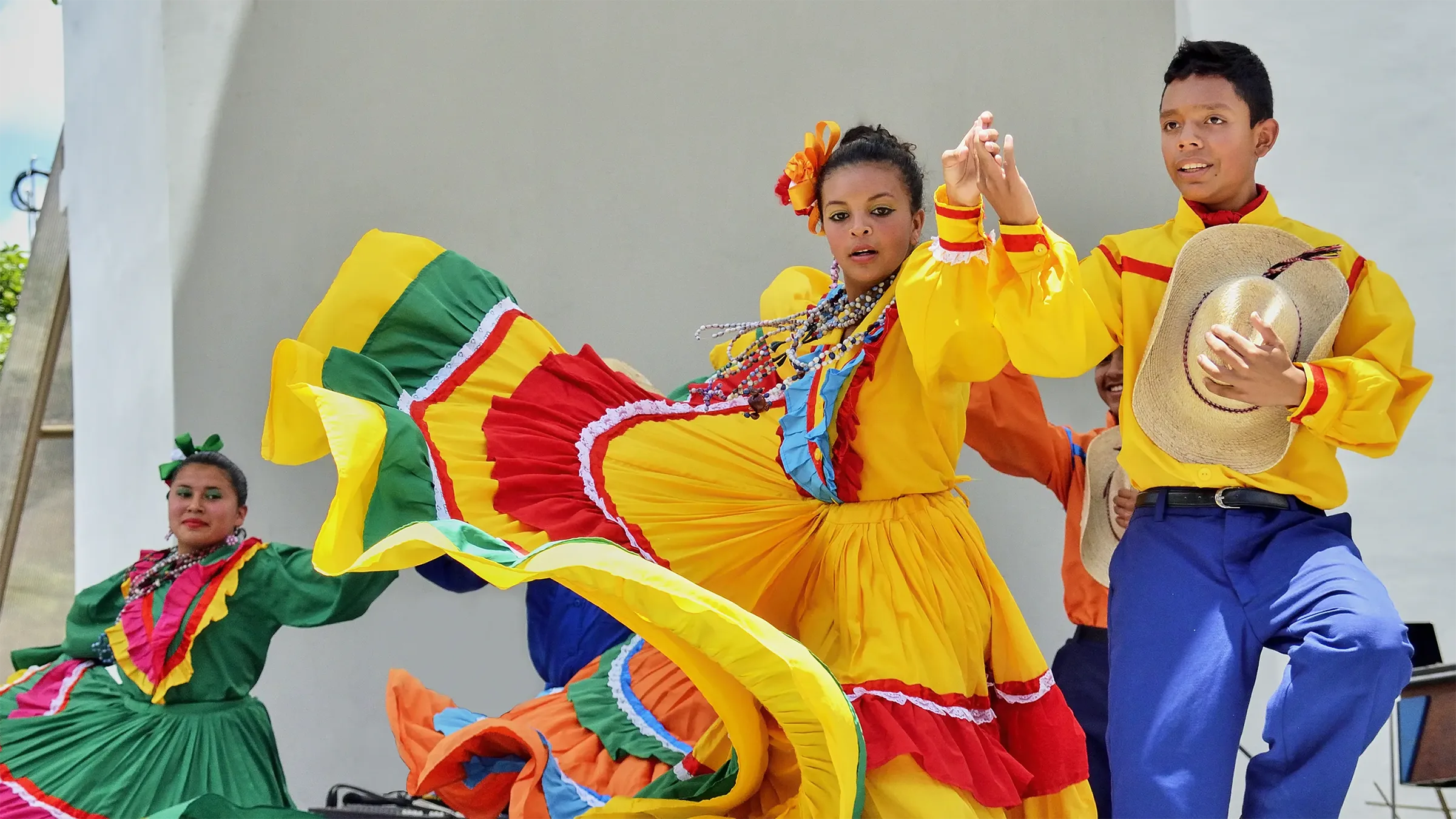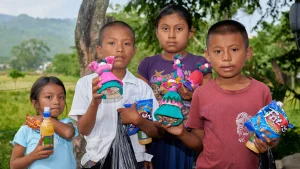Folk Dances of Honduras

In reality, Honduras has two very marked cultural areas: the peasant area of indigenous/mestizo and Afro-Caribbean origin; each representative in their folklore.
Within the indigenous peasant area, Creole dances, imitation Creole dances, peasant dances with indigenous influence, royal or colonial dances are subdivided.
In Afro-Caribbean dances, the dance of the tip, the dugu, the masks and others of the Garífuna ethnic group stand out. Currently Honduras has more than 141 folkloric dances.

Creole root dances
Creole (or mestizo) dances are the result of the mixture of indigenous and European cultures in the New World. The following are Creole dances that have been authenticated by the National Folklore Office:
- Uproot clods
- the barrel
- Cacautare Dance
- The Guancapla Chain
- the cascareño
- the colossuca
- The belt
- The Corrido to the Chapias
- The Run of the Chips
- The Quick Cutout
- the destro
- The Destrocón
- The Distro (and indigenous influenced)
- The Duyureña
- The Esquipuleño
- the farifumba
- In front of the Guatalera
- the guanesteño
- The Guapango Chilqueño
- The Guapango Chorotega
- The Guapango of the River
- The Jutiquile
- The Lilies
- musical machete
- The Green Stick
- The Green Stick of Guancapla
- the little combs
- La Picotena
- the piunga
- the polka run
- The Polka of the Enea
- Polka The Muffs
- Polka by Maria Luisa
- The Marked Polka
- Polka of the Bride
- Plate Polka
- The Pink Polka
- The Polka San Juan
- Raíces de los Castellanos or Corrido de las Fichas
- the scrambled
- the little dream
- The sigh
- the tronconera
- Destro Waltz (or El Palito Verde de Intibucá)
- The Xungui-Xungui
- The Zapateado
- The Paceño Zapateado
- the zarandita
Creole Imitation Dances
Creole imitation dances are dances that recall the characteristic movements of animals and also of some activities such as fairs, bullfights, frights, bird flights, and hunts.
- The ponies
- the ridge
- the coyota
- the gallop
- the garroba
- The Hawk
- The Pinto Bull
- The Vulture
Dances of indigenous roots
Indigenous dances are mainly influenced by pre-Columbian culture. The following are indigenous dances that have been authenticated by the National Folklore Office:
- the little accordion
- The Aguatera (or She Who Carries Water)
- Love in Puyitas
- Cachaças with Milk
- Chain
- La Campesina (originally from the department of Olancho)
- the colozuka
- The brooms
- The stake
- The Indian or Sad Bird (or Sad Bird?)
- Lime
- La Picotena
- the little stone
- The Indian Piece
- The Jumping Flea
- the flea
- The Tuno Sound
- You are an angel
- the little dream
- The Little Dream Lyrics
- tap sap
- Pinto Bull
- the stumble
- the tunnel
- the tusa
- The Xixique
- copal zapateado
Colonial Dances
Also called ballroom dances , these dances are colonial reminiscences due to acculturation and have been assimilated by the people without losing their traditional essence.
- the quiet
- the chotis
- The Queen’s Gang
- the spinal
- Yoreño syrup
- The Junco
- The Lancers
- The rain
- the mazurka
- the pereke
- Polka of the Hatillos de la Castaña
- Polca the San Juaneña
- Polka Flying
- The Warsaw
The Tip Dance
The Punta Dance is a dance form that has its own music, which the Garífuna ethnic group uses to celebrate their festivities. There are certain legends about the name of this dance, one of them mentions a funeral ritual.
There are records that it has been danced since the late 1970s by the inhabitants of the regions of Livingston, Dangriga and the cities of Tela, La Ceiba, Trujillo and Roatán in Honduras. La Banda Blanca popularized the punta rhythm and dance with their album Sopa de Caracol, making it known worldwide.
Stories of Folk Dances
Polka of the Rose
Popular mestizo party dance, due to its form and manner of dance it is a collective dance in couples. This musical piece was reported in Jocomico, Choluteca municipality by Rosa Osorto (QDDG) and the dancer and musician Amado de Jesús Varela, in August 1974 and rescued on September 10, 1985 in Cuesta La Julia or Jocomico II, Choluteca.
It was compiled by Tania Pinto de Moran, accompanied by her children José Armando, María del Pilar and Roberto Antonio Moran.
The brooms
This dance presents a series of choreographic figures from the butlers’ ceremony that they perform in honor of the Virgin of the Assumption (August 15), when they receive or deliver the charge while those in charge of keeping the temple clean carry brooms adorned with ribbons and flowers, the whole ceremony ends with a party.
Musical piece classified as dance of indigenous roots that was compiled by Rafael Manzanares Aguilar, in the town of Santa María in La Paz.
The Indian Piece
Dance that was danced in the patron saint festivities of the San Ramón Abajo hamlet, Linaca village, Choluteca municipality, Choluteca department. It presents love situations where the dancers always end up convincing their partners, celebrating the event with great joy.
It was reported by Justo Rufino Ordóñez, Marta Gómez and Rodrigo Álvarez, compiled by Tania Pinto de Moran, Auxiliadora Narváez and Reverend Jesús Valladares in 1977.
the tusa
Dance of indigenous roots reported in Cantarranas, today San Juan de Flores, department of Francisco Morazán and compiled by Lic. Rafael Manzanares Aguilar of the Department of National Folklore.
It takes its name from the corn cob wrapper, which is offered by the dancers to their partner, a joke that upsets their partner until they place an ear of corn or corn flower on her hair.
tat sap
Dance belonging to the Misquita culture, originally from the municipality of Brus Laguna in the department of Gracias A Dios. It was reported by the primary school teacher, Modesto Morales in the city of Tegucigalpa and compiled by Carlos Gómez and Rubén Ruiz from the National Folklore Department.
The Xixique
It is an onomatopoeic voice and its name is derived from the sound produced by the rubbing of the caite with the ground during the dance. It has a thermal rhythm with two soft beats and one strong beat. Due to the custom of the people today it is called «Xique» although in Cacautare they also call it «Quixique».
The dance was compiled by Mr. Rafael Manzanares Aguilar in the village of Cacautare, Municipality of Pespire, department of Choluteca.
Chain
This dance was compiled by Mr. Rafael Manzanares Aguilar, in the city of Olanchito, department of Yoro. It presents a series of choreographic figures and rounds that the dancers make during their execution, ending up intertwining their arms, releasing them at the end.
the little dream
Dance of the peasant area. This Dance is related to the sleep of the late-night dancers, but they have to wake up to continue with the party.
The dance originates from the village of Cacautare, Municipality of Pespire in Choluteca, through Mrs. Ubaldina Suazo de Salazar and compiled by Rafael Manzanares Aguilar.
Copal Zapateado
It was compiled in the Department of National Folklore by Father Jesús Valladares, parish priest of the Choluteca church. This dance was informed by Mr. Bonifacio Cruz Ramírez, 70 years old, who has been dancing since he was 18 years old, and Mrs. Victoria Murguía, 55 years old.
It was compiled and reported to the Department of National Folklore by Professor David Flores between the hamlets of Copal Arriba and Copal Abajo, processed in the musical part by the musicians of the National Dance and Dance Group by Professor David Flores and Alex Osorio, with the collaboration and research of Cesar Silva and Miss María Gabriela Irías.
According to the informants, this dance was performed in the meetings or tops, which were held in the region. The peculiar thing about this is the great competition that the dancers held with each other to demonstrate how skilled they were at dancing, since they demonstrated their manhood to the young ladies in this way and it was also the way to flirt with them. The difficult thing in this dance are the movements that are made, since you have to pass the handkerchief when dancing without losing the rhythm of the music, for this the dancers take off their shoes because the shoes prevented them from making the appropriate movements.
the little accordion
Dance of peasant origin with indigenous roots, originally from the Pavana village, Choluteca Municipality. This piece was one of the most popular in the area, danced at different festivities such as birthdays, weddings and festivities in the sector.
It was compiled in the Pavana village by Professor Óscar Armando Guevara and Professor Sara Emilia Mendoza and informed by Mr. Julio Rodríguez on March 16, 1990.
The Indian or Sad Bird
Dance with peasant roots investigated in the village of Copal Arriba, Municipality of Choluteca, department of Choluteca. This piece of music was danced for the patron saint fairs in honor of the Virgen de las Mercedes, which is celebrated on September 24. It was informed by Mr. Santos Seferino Ordóñez, who heard it for the first time from Mr. Santos Claro Marthel, who played it on the accordion under the name of Pájaro Triste”. Because it is a very agitated dance and with sudden movements, they called it «El indio».
This dance shows us the way our peasants dance during the feasts that take place in the southern region of the country. The different steps and way of dancing were taken from the dancers who attended the party. People from different places come to this patronal festival, such as: Copal Arriba, Copal Abajo, Fray Lázaro, Marillal, Jocomico, Trapiche, San Ramón, among others.
The Carnival of La Ceiba
This carnival is well known for its very cheerful music and dances, it is celebrated on the second Sunday of May, its music is recognized as MUEVELO, which is another way of calling this wonderful Honduran dance. This dance was made in honor of SAN ISIDRO LABRADOR, the name of this carnival (CEIBA) was adapted from the city LA CEIBA



